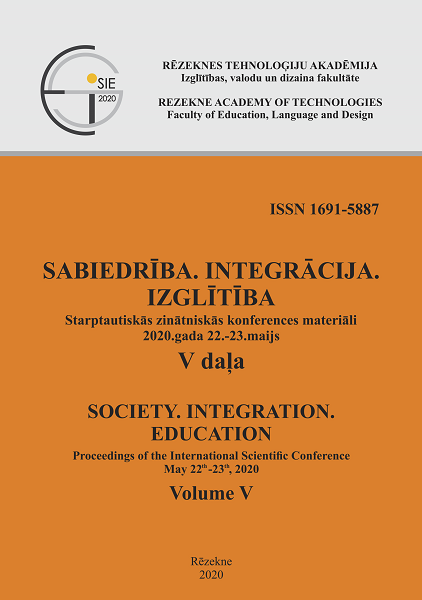THE EFFECT OF 3D PRINTING ON A TEXTILE FABRIC
DOI:
https://doi.org/10.17770/sie2020vol5.5012Keywords:
3D printing technology, experiments, textile fabric, the variance analysis methodAbstract
3D printing capabilities are also used in the fashion and textile industries. 3D printed textiles are a new opportunity to create an individual design. Traditional textile structures can be interpreted using 3D printing technologies and materials. One of the most important factors associated with the use of 3D printing technology is to reduce the impact of processing on the physical properties of textile fabrics. Availability of 3D printers at Rezekne Academy of Technologies (RTA) provides experimental work with fabrics of different thickness and fibres as well as different filaments. This study is based on the analysis of synthetic fibre cloth processing and the effect of 3D printing parameters on textile materials. By applying successive layers of materials, the interaction between 3D printing and textiles is studied. In terms of adhesion and stability, the best adhesion parameters for a particular type of fabric are determined by analysing the type of the fabric. The variance analysis method is used to process the research results.
References
Attaran, M. (2017). The rise of 3-D printing:The advantages of additive manufacturing over traditional manufacturing. Business horizons, 1, 1-12.
Brooks, M. (2016). The day the world became 3D. New Scientist, 232(3096), 40–41.
Brown, T. & Martin, R. (2015). Design for action. Harvard Business Review, 93(9), 58–64. Retrieved from https://hbr.org/2015/09/design-for-action
Burke, S. & Sinclair, R. (2015). Computer-Aided Design (CAD) and Computer-Aided Manufacturing (CAM) of Apparel and other Textile Products. Materials, Design and Technology. Textiles and Fashion. Materials, Design and Technology. Woodhead Publishing Series in Textiles, eBook. Skatīts 15.12.2019. Database: ScienceDirect
Carasella, M. (2016). Harmonograph dress and pangolin dress. Retrieved from https://3dprintedart.stratasys.com/threeasfourharmonographandpangolin/
Chatterjee, K. & Ghosh, .T. K. (2019). 3D Printing of Textiles: Potential Roadmap to Printing with Fibers. IOP Conference Series: Materials Science and Engineering. Article Number: 1902086. Database:Web of Science
Flynt, J. (2019). 3D Printing Fashion: Advantages, Disadvantages, and Future. Retrieved from https://3dinsider.com/3d-printing-fashion/
FDM printer. (n.d.) Retrieved from https://www.geekbuying.com/item/SUNKIN-D220-Cloud-based-DIY-FDM-3D-Printer-Black-398723.html
Gebler, M., Schoot Uiterkamp, A.J.M., & Visser, C. (2014). A global sustainability perspective on 3D printing technologies. Energy Policy,74, 158–167.
Grieser, F. (2019). FDM printera darbības princips. Retrieved from http://apm-designs.com/fdm-vs-sla-3d-printer-tech-comparison/
Kolko, J. (2015). Design thinking comes of age. Harvard Business Review, 93(9), 66–71. Retrieved from https://hbr.org/2015/09/design-thinking-comes-of-age
Mageean, L. (2018). The Rise of 3D Printing in Fashion. Retrieved from https://www.whichplm.com/rise-3d-printing-fashion/
Minjoo, K. & Sungmin, K. (2019). Fabrication of 3D printed garments using flat patterns and motifs. International journal of clothing science and technology, 31(5), 653-662.
Moore, D. S. (2004). The basic practice of statistics / David S. Moore. 3d ed. New York: W.H.Freeman and Company.
Pasricha, A. & Greeninger, R. (2018). Exploration of 3D printing to create zero-waste sustainable fashion notions and jewelry.
Peleg, D. (2018). Liberty leading the people. Retrieved from https://danitpeleg.com/liberty-leading-the-people-2/
Perry, A. (2018). 3D-printedapparel and 3D-printer: exploringadvantages, concerns, and purchases. International Journal of Fashion Design, Technology & Education, 11(1), 95-103.
Report on 3D-printing: Current and future application areas, existing industrial value chains and missing competences in the EU (2016). Retrieved from https://ec.europa.eu/growth/content/report-3d-printing-current-and-future-application-areas-existing-industrial-value-chains-0_en
Richa (2018). 3D Printing on fabric. Retrieved from http://www.geeetech.com/blog/2018/02/3d-printing-on-fabric-is-easier-than-you-think/
Richardot, A. (2018). 3D printed fashion: Why is additive manufacturing interesting for fashion? Retrieved from https://www.sculpteo.com/blog/2018/01/24/3d-printed-fashion-why-is-additive-manufacturing-interesting-for-fashion/
Roach, J.D., Hamel, M.C., Dunn, K.C., Johnson,V.M., Kuang, X., & Jerry,X. (2019). The m4 3D printer: A multi-material multi-method additive manufacturing platform for future 3D printed structures. Additive Manufacturing, 29(100819).
Shahrubudin, N., Lee, T.C., & Ramlan R. (2019). An Overview on 3D Printing Technology: Technological, Materials, and Applications. Procedia Manufacturing, 35, 1286–1296.
Swack, M. (2016). New York Fashion Week: New Movement in 3D Printed Fashion By ThreeASFOUR, Travis Fitch and Stratasys.Retrieved from http://blog.stratasys.com/2016/02/16/3d-printed-dresses-new-york-fashion-week/
Teuku, A. (2014). Iris van Herpen Spring 2015 RTW. Retrieved from https://www.dewmagazine.com/iris-van-herpen-spring-2015-rtw/
Vanderploeg, A.,Lee, S-E., & Mamp, M (2017). The application of 3D printing technology in the fashion industry. International Journal of FashionDesign, Technology & Education, 10(2), 170–179
What is 3 D printing. (2019). Retrieved from https://3dprinting.com/what-is-3dprinting/
Welson-Rossman, T. (2018). 3-D Printing Poised To Revolutionize The Fashion Industry. Retrieved from https://www.forbes.com/sites/traceywelsonrossman/2018/02/07/3-d-printing-poised-to-revolutionize-the-fashion-industry/#61678534170f






